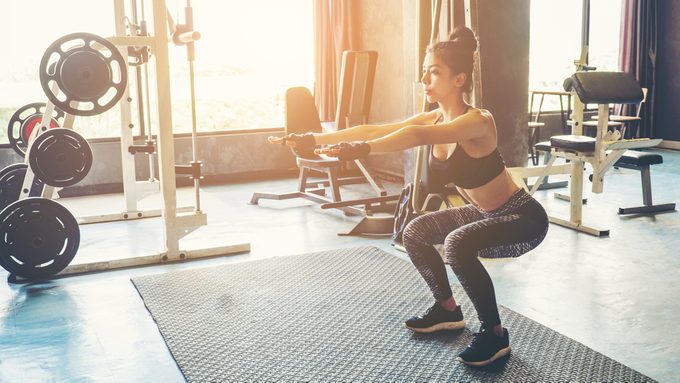This Is How Many Squats It Takes To See Results
One, two, three, four…

Knowing how to perform squats safely and effectively is key to seeing results. Specifically, if you want to grow your gluteus muscles—commonly called “the glutes”—there are a few important factors to keep in mind.
First, Jim White, an ACSM exercise physiologist and personal trainer, notes that there is no official magic number of squats that will automatically show results. But most trainers agree on a similar ideal starting point: squatting two to three times a week for roughly three to five sets of eight to twelve squat reps. For the sake of simplicity, try squatting at least three times a week for five sets of ten. That works out to be 150 squats per week. Totally doable, right? You should start to see results in four to six weeks.
The specific weight used, however, may vary based on skill level and mobility—not gender. “The amount lifted will depend on factors such as the person’s own body weight, fitness level, age, and body structure and leverages,” says Robert S. Herbst, a trainer, and 19-time World Champion Powerlifter. Herbst advises breaking up your squatting frequency as well and including rest days between your squatting workouts. (Thinking about hiring a personal trainer? Make sure you ask them these questions first.)
Here’s how to complete a proper squat: make sure you raise your chest, look forward, place your feet a bit wider than shoulder width apart, engage your stomach muscles, and think about sitting back—not down. Avoid leaning forward too much which could stress your lower back, Herbst adds. And don’t allow your knees to bow inwards.
Even if you stick to a strict squatting routine, you are only hurting yourself if you perform them improperly, says Paul Kostas, a personal trainer and the Director of Personal Training at the Brooklyn Athletic Club. “Muscles respond very well to being loaded at a full stretch, or end range of motion,” Kostas says. “Squatting all the way down, even with less weight, will promote growth and strength as well joint health.” Here are other fitness mistakes you should avoid.
Ariel Osharenko, a strength and conditioning coach, physical therapist, and a USA Olympic weightlifting coach, agrees to check your ego at the door when it comes to starting squat weight. “As you gain strength over time, you can begin gradually increasing the weight you squat,” he says. “You don’t want to make the mistake of squatting too heavy, which could lead to injury if done improperly.” Combining too-heavy squats with improper form could also lead to muscle imbalances, Herbst warns.
To get the most out of your squats, you should also include different variations. According to James Shapiro, a New York-based personal trainer, not changing up the type of squat you perform is a missed opportunity for growing the glutes. “Variations are key and sometimes using a goblet squat, sumo dumbbell squat, or Bulgarian split squat can be as or more efficient than a normal body weight or barbell squat,” Shapiro says.
Once you have the proper technique down, incorporating additional lower body moves such as lunges will help bring the biggest glute gains. And in addition to a stronger and larger butt, Osharenko says squats are especially great compound moves that can help you gain power, increase core stability, and improve joint health and flexibility. All the more reason to squat it out. Want more booty-shaping exercises? David Beckham’s trainer shares her fave glute activation workout. And, don’t miss the best workout for your age.




